Sew What! Bags: 18 Pattern-Free Projects You Can Customize to Fit Your Needs (32 page)
Read Sew What! Bags: 18 Pattern-Free Projects You Can Customize to Fit Your Needs Online
Authors: Lexie Barnes

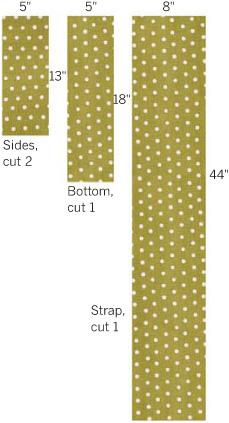
1.
DECIDE YOUR SIZE
. You might want this bag for work or school, or maybe for the gym. Whatever you decide, you can tailor this bag to suit your needs perfectly. Just put a little planning into it before you get started. Figure out what size bag you want to make and how long your strap will be.
To get a good measurement for your strap: take measuring tape or some string and measure from your hip across your chest to your shoulder, and back again to your hip.
2.
CUT YOUR FABRIC
. Draw the pieces on the wrong side of the fabric and cut out the following:
primary fabric: one front, one back, two sides, one bottom, and one strap
contrasting fabric: two flap pieces, one front and one back pocket panel, and two side pockets
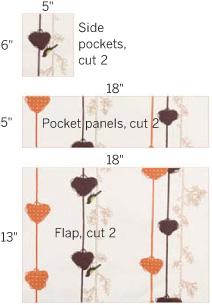
3.
MAKE THE SIDE POCKETS
. Press under the top of the side pocket ¼", then again another ¼". Edgestitch along the bottom fold. Repeat with other pocket. Pin the pockets to the side panels, right sides facing out. (The pockets should be the same width
as the side panels, so stitching the side seams will hold the pockets in place.)
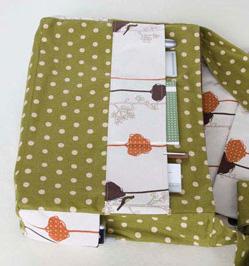
ø
This bag has enough pockets to fit anything you want them to, so think about what you’d like to bring along in your satchel. Your phone and MP3 player? How about your checkbook and your shades? A notebook and some pens? I always need a designated pocket for my keys, some gum, and my favorite tape measure. Have fun and plan your pockets to fit your stuff, your way.
CORNER POCKET
A couple of things to consider when you are choosing the size and placement of your pockets:
Pocket height should be played with until you are sure you like where it is. If your pocket is too high up on the bag or too short, items may stick out of it. If the pockets are too low or too deep, you may have trouble getting to your stuff.
If the pockets are not strong enough at the top, the fabric will sag and your goodies will fall out. It’s a good idea to use bias tape to bind the top of your pockets (
see page
46
), or to double-stitch them for reinforcement.
4.
MAKE THE POCKET PANELS
. Press the top of the front pocket panel under ¼" and again ¼". Edgestitch along the bottom fold. Also, press under the bottom edge ¼" and edgestitch. Position and pin the pocket to the front bag panel. (We lined up the bottom of this panel with the top of the side pockets, but place it wherever you like.) Stitch along the bottom. Using chalk or pencil, mark dividing lines for pockets, based on your needs. Stitch along the dividing lines, backtacking at both ends. Do the same for the back, but if you are placing this pocket at the bottom seam, like ours, there is no need to turn under the bottom edge; it will be stitched into the seams of the bag.
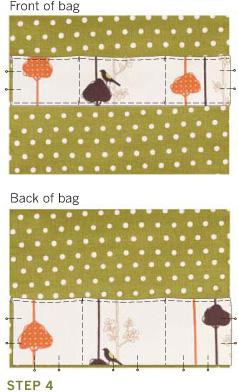
5.
STITCH THE BAG
. With right sides together, pin the sides and bottom panels into one long strip. Make sure the side panels are placed with the pocket tops facing the right way. Stitch the seams, starting and ending ½" from the edges (as shown with dots) and backtacking. Press seams open. With right sides together, pin the sides and bottom to the front panel. Stitch with sides on top, pivoting at the corners. Attach the sides and bottom to the back panel of the bag in the same way. Press seams open.
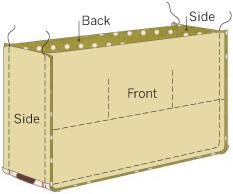

6.
MAKE AND ATTACH THE STRAP
. With right sides together, fold the strap in half lengthwise and stitch the entire length. Trim the seam allowance, turn the strap right side out, and press. (
See page
42
.) Edgestitch if you like. With right sides together, pin the ends of the strap to the top edges of the side panels, and stitch.
